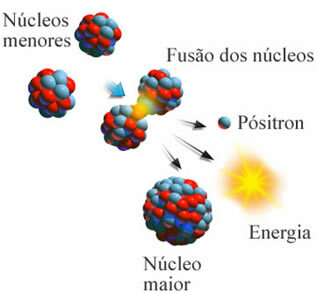The hydrogen bomb or H bomb is based on the uncontrolled nuclear fusion reaction. A nuclear fusion occurs when two smaller nuclei unite to form a larger, heavier nucleus, releasing a colossal amount of energy.

For example, this type of reaction is what happens in the Sun, where 4 protons (hydrogen nuclei) come together to form a helium nucleus, releasing a positron and a large amount of energy:

However, for this type of reaction to occur, extremely high temperatures are required, such as those that exist in the Sun, in the order of 10 million degrees Celsius, to overcome the repulsion forces between the positive charges in the core.
Thus, to get a nuclear fusion reaction to start, putting the H-bomb into operation, atomic bombs are exploded, which provide the energy necessary for activation.
The fusion that takes place in the H-bomb is not between hydrogens like that of the Sun, but between its isotopes, deuterium (12h or 12D) and tritium (13h or 13T). This reaction releases more energy and occurs at an even greater speed:

The following is a schematic of the hydrogen bomb:
Do not stop now... There's more after the advertising ;)

In reservoir A, an amount of lithium hydride is placed, which acts as a source of deuterium and tritium, and further increases the speed of the energy released, because when lithium (36Li) is reached by the neutrons released in the fusion, it undergoes a nuclear transmutation and generates more tritium for the reaction. This reservoir is also surrounded by several small atomic bombs (in purple and orange) which, as explained above, will detonate and provide the energy needed to initiate the fusion. In casing C, there is uranium 238 which helps to increase the explosive strength of the hydrogen bomb.
Nuclear fusion releases much more energy than nuclear fission (the base reaction of the atomic bomb). Thus, it is estimated to have a destructive power about 700 times greater than the bomb that was dropped on Hiroshima.
In the year 1953, the first hydrogen bomb was launched by the Americans, as a test only. In the same year, the Russians also carried out explosions of this type of bomb. Between 1956 and 1957, 18 explosions were recorded at an experimental level by the Americans, British and Russians.
These tests stopped when scientist Linus Pauling managed to make the cited countries signed an agreement in 1964 pledging not to carry out any further tests with nuclear bombs in the air open.
By Jennifer Fogaça
Graduated in Chemistry
Would you like to reference this text in a school or academic work? Look:
FOGAÇA, Jennifer Rocha Vargas. "Hydrogen bomb"; Brazil School. Available in: https://brasilescola.uol.com.br/quimica/bomba-hidrogenio.htm. Accessed on June 27, 2021.


